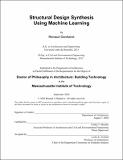| dc.contributor.advisor | Caitlin T. Mueller. | |
| dc.contributor.author | Danhaive, Renaud Aleis Pierre Emile. | en_US |
| dc.contributor.other | Massachusetts Institute of Technology. Department of Architecture. | en_US |
| dc.date.accessioned | 2021-12-17T18:24:23Z | |
| dc.date.available | 2021-12-17T18:24:23Z | |
| dc.date.copyright | 2020 | en_US |
| dc.date.issued | 2020 | en_US |
| dc.identifier.uri | https://hdl.handle.net/1721.1/138590 | |
| dc.description | Thesis: Ph. D. in Building Technology, Massachusetts Institute of Technology, Department of Architecture, September, 2020 | en_US |
| dc.description | Cataloged from the official pdf of thesis. | en_US |
| dc.description | Includes bibliographical references (pages 203-219). | en_US |
| dc.description.abstract | This dissertation investigates how data-driven methods may support creative, performance-informed design processes for early-stage building and structural design. Given the imperative to curb greenhouse gas emissions, designers have an increased responsibility to consider the environmental impact of their decisions early on in the design process when they have outsize effects on a building's environmental performance. Although existing methods of optimization and design space exploration can guide designers toward better design options based on simulation data, there remain significant hurdles to the effective adoption of these tools despite their potential benefits. First, many engineering simulations remain cumbersome to connect with and slow to run, disrupting the pace of a fluid design process. Second, the design spaces used to generate and evaluate design variations are so vast that they are virtually impossible for humans to effectively explore. Finally, due to the intrinsically human nature of architecture and design, there is strong resistance to any process which purports to fully automate it. This dissertation addresses these challenges by proposing three strategies that capitalize on recent advances in deep learning to connect the power of performance-driven computing with the fluidity and creativity of human design and help human designers explore complex structural design spaces more intuitively. The first approach uses convolutional neural networks to expand surrogate modeling, which substitutes fast data-driven approximations for slow engineering simulations, from the prediction of single metrics to entire simulation fields. This reveals how performance is distributed spatially, providing more holistic feedback than previously possible. Two case studies show how this can uniquely link shape exploration and design materialization in fast and responsive ways. The second strategy introduces a sequential sampling algorithm that can help increase the effectiveness of many data-driven design approaches by helping build high-quality design datasets. Finally, the third approach takes advantage of the proposed sampling scheme to train deep generative models with low-dimensional latent spaces that can be intuitively explored by human designers to synthesize diverse structures with prescribed performance levels. Cases studies spanning different typologies and scales illustrate these approaches and demonstrate how harnessing advances in machine learning can amplify human creativity in structural design. | en_US |
| dc.description.statementofresponsibility | by Renaud Danhaive. | en_US |
| dc.format.extent | 219 pages | en_US |
| dc.language.iso | eng | en_US |
| dc.publisher | Massachusetts Institute of Technology | en_US |
| dc.rights | MIT theses may be protected by copyright. Please reuse MIT thesis content according to the MIT Libraries Permissions Policy, which is available through the URL provided. | en_US |
| dc.rights.uri | http://dspace.mit.edu/handle/1721.1/7582 | en_US |
| dc.subject | Architecture. | en_US |
| dc.title | Structural design synthesis using machine learning | en_US |
| dc.type | Thesis | en_US |
| dc.description.degree | Ph. D. in Building Technology | en_US |
| dc.contributor.department | Massachusetts Institute of Technology. Department of Architecture | en_US |
| dc.identifier.oclc | 1288574413 | en_US |
| dc.description.collection | Ph. D. in Building Technology Massachusetts Institute of Technology, Department of Architecture | en_US |
| dspace.imported | 2021-12-17T18:24:23Z | en_US |
| mit.thesis.degree | Doctoral | en_US |
| mit.thesis.department | Arch | en_US |
